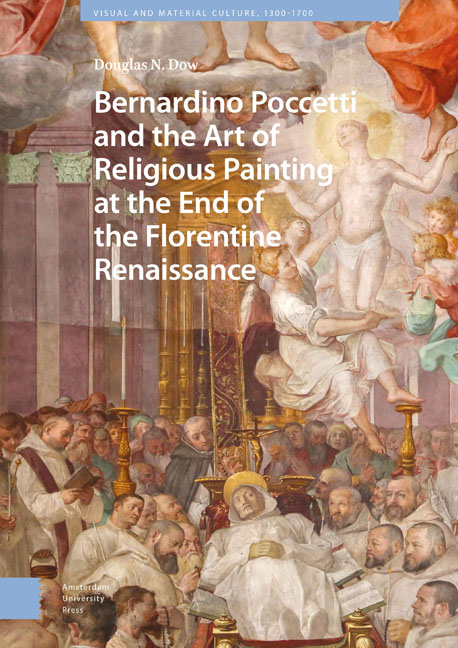Book contents
- Frontmatter
- Contents
- List of Illustrations
- List of Abbreviations
- Acknowledgments
- Introduction: ‘Il primo huomo da dipingere in fresco, che sia in questi paesi’: Bernardino Poccetti and the Historiography of Florentine Painting during the Late Renaissance
- 1 ‘Grandemente inclinato all’Arte del Disegno’: Filippo Baldinucci’s Biography of Bernardino Poccetti
- 2 ‘Le prime cose lodevoli molto’: Bernardino Poccetti’s Early Work and the Frescoes from the Life of Saint Dominic in the Chiostro Grande, Santa Maria Novella
- 3 ‘Locum ecclesiae designavit, quae Ioannis et uxoris pecunia extructa est’: Bernardino Poccetti and the Decoration of the Canigiani Chapel in Santa Felicita
- 4 ‘Miracula et alia id genus’: Bernardino Poccetti’s Frescoes in the Church of San Lorenzo at the Certosa del Galluzzo
- Color Plates
- 5 ‘L’inventore di dipingere tutte le muraglie della nostra chiesa’: Bernardino Poccetti and the Sixteenth-Century Decoration of Santa Maria del Carmine
- Conclusion
- Bibliography
- Index
Conclusion
Published online by Cambridge University Press: 13 February 2024
- Frontmatter
- Contents
- List of Illustrations
- List of Abbreviations
- Acknowledgments
- Introduction: ‘Il primo huomo da dipingere in fresco, che sia in questi paesi’: Bernardino Poccetti and the Historiography of Florentine Painting during the Late Renaissance
- 1 ‘Grandemente inclinato all’Arte del Disegno’: Filippo Baldinucci’s Biography of Bernardino Poccetti
- 2 ‘Le prime cose lodevoli molto’: Bernardino Poccetti’s Early Work and the Frescoes from the Life of Saint Dominic in the Chiostro Grande, Santa Maria Novella
- 3 ‘Locum ecclesiae designavit, quae Ioannis et uxoris pecunia extructa est’: Bernardino Poccetti and the Decoration of the Canigiani Chapel in Santa Felicita
- 4 ‘Miracula et alia id genus’: Bernardino Poccetti’s Frescoes in the Church of San Lorenzo at the Certosa del Galluzzo
- Color Plates
- 5 ‘L’inventore di dipingere tutte le muraglie della nostra chiesa’: Bernardino Poccetti and the Sixteenth-Century Decoration of Santa Maria del Carmine
- Conclusion
- Bibliography
- Index
Summary
This book has analyzed only a few of Poccetti's many works, but each case study demonstrates the various ways that these decorative interventions responded to and shaped the concerns regarding religious painting in Florence at the end of the Renaissance. In the Chiostro Grande at Santa Maria Novella, for example, Poccetti's treatment of scenes from the life of Saint Dominic recast the historical episodes of Dominic's efforts to fight heresy, updating them to resonate with the concerns of late sixteenth-century Catholics, who were struggling with their own schismatic sects. At the Canigiani Chapel, Poccetti depicted the miraculous snowfall on the Esquiline hill that led to the foundation of Santa Maria Maggiore. The feast celebrating this miracle had recently been elevated by the Roman Church, which promoted it because it emphasized traditional priorities regarding charitable works and the efficacy of saintly intercessors, the Virgin in particular. Furthermore, the saints in the chapel's pendentives and representations of high-ranking ecclesiastics in the mural reflected the identities and concerns of its patrons. At the Certosa del Galluzzo, Poccetti's cycle representing the life of Saint Bruno expanded and amplified the somewhat modest iconography of the Carthusians’ founder. In so doing, it not only set the tone for other more widely disseminated images of the saint's life, but also presented an image of the order that conformed to its self-perceptions even as it offered a glimpse of how the Carthusians could make a vital contribution to Catholicism in the period of reform. At Santa Maria del Carmine, the large frescoes of the apostles lining the nave stood as a reminder of the Roman Church's antiquity and its origins in Christ and his original ministry, presenting a powerful rebuttal to recently founded Protestant splinter groups. By completing the decoration with fictive colored-marble revetments, Poccetti brought the interior of the Carmine up to date by reflecting the fashion for luxuriously revetted chapels then current in Florence, while simultaneously evoking the splendor of ancient and papal Rome, underscoring the Latin Church's long history and its commitment to its traditional splendor and luxury.
- Type
- Chapter
- Information
- Bernardino Poccetti and the Art of Religious Painting at the End of the Florentine Renaissance , pp. 277 - 282Publisher: Amsterdam University PressPrint publication year: 2023



